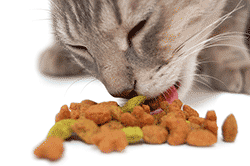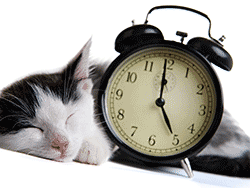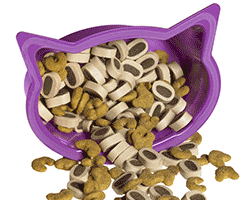Feeding basics
Feeding can be a complex subject, but all you need at the beginning are the basics

Equipment
You will need three feeding bowls for your cat, one for wet food, one for dry food, and one for water. Most cats are not too bothered about the style of bowl, but occasionally noisy bowls (when knocked against each other or the floor) are disliked and may even put a cat off feeding. Bowls should be wide rather than deep, so that your cat does not have to get its whiskers right in the bowl. Cats are much tidier eaters than dogs, but will still drop a few pieces on occasion so a feeding mat is a good idea, and this will also act as an identifying object for your cat, designating the area as a feeding place.
Where to feed
A good spot for your cat to feed is anywhere quiet, secure, and well away from toilet areas. Most owners feed their cats in the kitchen for convenience, but you could feed anywhere in the house. Try to make a rule with your cat that kitchen worktops are no-go areas, or you may soon find your cat exploring and getting into trouble by eating scraps of food it shouldn't, or knocking over knifes or wine glasses. Kitchens have plenty of dangerous spots for cats (ovens, hobs, washing machines) so are not good places for your cat to hang around. By only feeding your cat in its feeding area, you can keep attention focused on this 'safe area'.
Food types
Most adult cats are fed on both 'wet' and 'dry' foods which cover all of a cats nutritional requirements, and are called 'complete' foods. Wet foods form the bulk of the diet, are usually made up from meaty chunks in either a jelly or gravy substance, and come in tins and pouches. Pouches are enough for a single feed and offer a simple convenient, no mess solution. Tinned foods are better value and contain two to three feeds per tin, but once opened must be kept fresh in the fridge, and in some cases warmed slightly before feeding (some cats don't like cold food)
Dry food comes in small biscuit form and in bulk packets (like breakfast cereal) and is normally used as a supplementary food which can be left out for long periods. Whilst dry foods are 'complete' foods, they contain very little moisture, so should not be fed exclusively. Even if a cat has access to water, it may not drink enough to make up the shortfall of a dry food only diet. Your cat needs a supply of water at all times to prevent dehydration, tapwater is fine and should be replaced daily. Milk is not required and may actually cause stomach upsets, so water is best.

Is it lunchtime yet? Cat's can get used to a routine which suits you
How often to feed your cat
A natural diet for a cat consists of several small meals a day, and most experts agree that small feeds are best for cats. Two feeds a day of a wet food along with a dry food for your cat to dip in and out of whenever it feels the need is probably about right. Setting a regular time for feeds can help add structure to you and your cats lives, but the exact timings are not critical. A feed in the morning and a feed early evening at a time which suits you is fine.
How much to feed your cat
This can be a complicated subject, as a definitive answer would have to take into account your cats age, size, activity levels, and maybe even breed. The best approach is to obtain your cat's weight and assuming your cat is not over or underweight, follow the guidelines on food packaging. Most foods offer a guide based on the weight of your cat, although amounts do vary from one food to another because of the differences in nutrient content of different foods.

If fed in large quantities every day, a treat is no longer a treat
Cat treats and human foods
The pet care market is flooded with all sorts of different cat 'treats' and there is no harm in using treats - they are good fun, encourage bonding, and cats love them. However, they must be limited and controlled, or you run the risk of your cat having weight or nutritional problems. If you feel like giving your cat the occasional treat from your own plate, bear in mind that this could encourage begging behaviour, or even stealing food right of plates. It is better to wait until everyone has finished, and then put any treats in the cats bowl, or away from the area of human eating. Remember that the food we eat is not always suitable for cats, and even if you think it must be safe, it can be poisonous - for example, onions, chocolate, and raisins are dangerous for cats!



